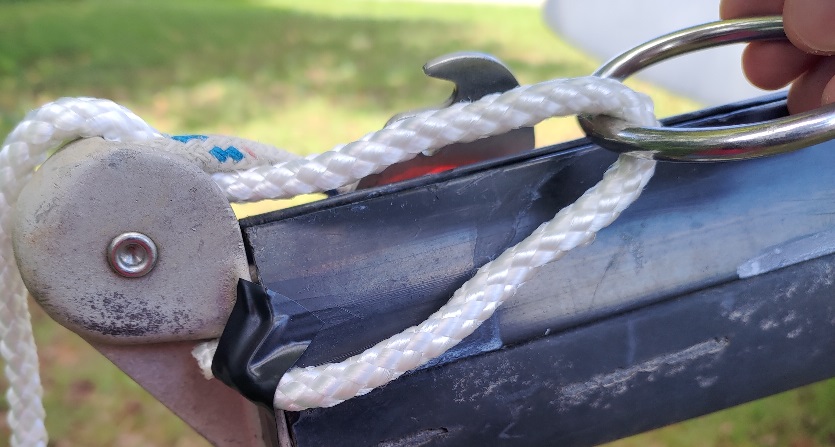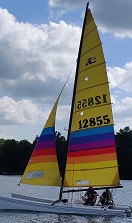We have been having a little trouble raising the main sail. I have thoroughly cleaned the luff and track and lubed the track LIBERALLY with dry Teflon spray. Everything goes ok for the first half, progressively getting harder along the way. After getting to half, it gets pretty tough, and again, gets harder as we go. By the time the main is completely up, my crew is pulling so hard on the halyard, he has to use his upper body and his legs pushing on the crossbar to get the sail all the way up. The whole time, I'm feeding the sail into the track. If I didn't know its impossible, I'd swear the halyard would break. I have triple checked the track and luff and found no apparent problems and the pulley wheels at the top and bottom of the mast roll smoothly with little friction. Additionally, dropping the main is super easy, it almost falls completely down on its own. It only needs help getting started (unhooking) and the last 1/4 or so (assuming the wind doesn't help).
This got me thinking, is there a multiple purchase system for the main halyard?
If not, I was thinking I could run the halyard from the mast head, through the locking ring on the leech side of the ring, then back up to the mast head. I would attach the halyard on the opposite side from the hook, to encourage the ring to twist toward the hook. Anyone see any problems with this? Would attaching a pulley to the top of the ring be feasible and/or helpful (concerned about space and lack of twist)?
Of course, if there is some other problem I haven't already checked for, I'm open to those suggestions as well.
EDIT: I had a chance to get to the boat and get a pic to better explain what I'm considering. In the process, I kind of discovered the answer to my last question: Unless someone knows of a suitably small and strong pulley, it doesn't look like adding a pulley will work, I don't think there is enough room.

Some notes on the image:
- The white line is not my halyard, the grey and blue one is. The white line is what I plan to do (assume it would go into the mast head, rather than over it at the pulley).
- The electrical tape is just there to hold the line in place for the picture. My best idea right now is to drill a hole where the white line ends, right in that corner where the white line ends, just barely big enough for the halyard. The halyard would go through the hole and have a stop knot on the other side.
- With this configuration, I would be replacing the halyard with a smaller but stronger line and something slick, probably 5mm dyneema. Any suggestions for a better line would be appreciated, I chose dyneema because of my dyneema trampoline lines which are pretty slick.
- Yes, that ring is smaller, its actually a spare trap ring. It was easier to use that than to remove the halyard ring (that knot is TIGHT).
Thanks,
Kyrle









